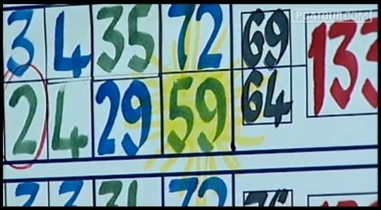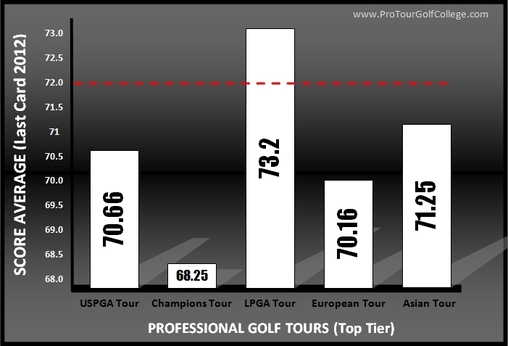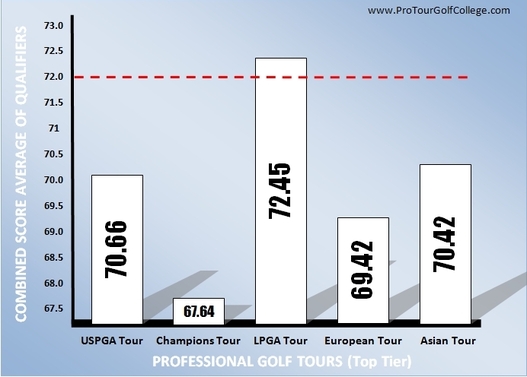 Many golfers from all over the world travel to golf course venues from one side of the globe to the other to attempt to qualify to gain playing privileges on a major golf tour like the PGA Tour, Champions Tour, LPGA Tour, European Tour or the Asian Tour. Sadly most of these golfers will fail to qualify for one simple and overlooked reason; their golf score average is not low enough. Upon reflection they might blame their poor putting or a deficient golf swing technique, but the bottom line in professional golf is the low score average reigns supreme and they were not able to produce the numbers required to gain their card.  Harrison Frazer Shot 59 at US PGA Q School in 2009 It’s interesting to note that whether you play on a major golf tour or a minor golf tour the scoring standard is extremely competitive. From the Pro Am Tours of Australia (where Australia has developed the majority of their great golfers) to the Mini Tours of the USA, and onto the Asian Development Tour, the scoring standard on every professional golf tour is extremely competitive. You need to consider carefully spending your hard earned money to travel to a top tier qualifying school. And you need to know that you can produce the numbers required. So how good do you really have to be to qualify to play on a professional golf tour? In today’s article I’m going to look at the playing standard you need to achieve to be able to qualify to play on a major golf tour. USPGA TOUR QUALIFYING SCHOOL – Final Stage Results (November 30 - Dec 5, 2011) PGA West - Nicklaus Tournament Course Par 72 (7,204 Yards) TPC Stadium Course Par 72 (7300 Yards) In the graph above you can see that I’ve compiled the scoring averages required to gain the last card on 5 of the top tier professional golf tours. (No data available for the Japan Golf Tour Q School) On the US PGA Tour to gain the last card to play the 2012 season you needed a score average of 70.66 for 6 rounds of golf (- 8) against a par of 72 played on 2 golf courses that measure over 7,200 yards in length. (Click on the image below to make it larger)  Billy Mayfair at 44 years of age had to go back to Q School in 2010 after playing nearly 700 tournaments on the PGA Tour. He was medalist at 2010 Q School with rounds of 69 69 68 68 67 (-18) earning his card back to compete in his 23rd year on the PGA Tour. In 2011 he played in 29 tournaments, made the cut in 17 and earned $780,578 for 119th on the money list to keep his card for the 2012 season. So far in 2012 he's earned over 500,000 and is on track to keep his card for 2013. USPGA CHAMPIONS TOUR Q SCHOOL – Final Stage Results (November 13 – 16 2011) TPC Scottsdale – (Champions) Par 71 (7,115 Yards) On the Champions Tour the scoring was red hot and to gain a conditional card you needed a score average of 68.25 (- 11) and to gain a full card (5 full cards offered are highlighted) for 2012 you required a score average for 4 rounds of 67.5 (- 14) against a par of 71 on a golf course measuring 7115 yards. Jeff Freeman Freeman, a 50-year-old former club professional at the Country Club of Orlando and the 1999 PGA Professional Player of the Year took top medallist honors with 20 under for the 4 rounds and a combined score average over 4 rounds of 66.0. Watch this great interview with Patrick Horgan III who gained the fifth full card as he describes the pressure playing the 2011 Champions Tour Q School. USLPGA TOUR QUALIFYING SCHOOL – Final Stage Results (November 30 – Dec 4 2011) Legends Course Par 72 (6,594 Yards) and Champions Course Par 72 (6,664) Daytona Beach Florida  On the LPGA Tour to get the final card for the 2012 season you needed a score average over 5 rounds of 73.2 (+ 6) against a par of 72 on 2 golf courses measuring over 6,500 yards. 23 year old Junthima Gulyanamittafrom Thailand is a member of Purdue University's 2010 NCAA championship team. She took top medallist honors with 10 under par for the 5 rounds and a combined score average of 70.0. On the Ladies European Tour (LET) 30 cards were on offer at their final stage and the last card required a score average over 5 rounds of 73.6 against a par of 72. Jodie Ewart from England took top medallist honors with 11 under for the 5 rounds and a combined score average for the 5 rounds of 70.0. (Click on the image below to make it larger) EUROPEAN TOUR QUALIFYING SCHOOL – Final Stage Results (December 10 – 15 2011) PGA Catalunya Resort Par 72 (7,172 Yards) Girona Northern Spain  On the European Tour to gain the last card at their qualifying school to play the 2012 season you needed a score average of 70.16 (- 7) for 6 rounds of golf against a par of 72 played on 2 golf courses that measure over 7,100 yards in length. David Dixon from England took top medallist honors for the 6 rounds with scores of 74 65 63 69 67 69 for a 21 under par total and a combined score average of 67.83. ASIAN TOUR QUALIFYING SCHOOL – Final Stage Results (January 18 – 21 2012) Springfield Royal CC & Imperial Lakeview Par 72 (7,043 Yards) Hua Hin, Thailand  On the Asian Tour to gain the last card to play the 2012 season you needed a score average of 71.25 (- 3) for 4 rounds of golf against a par of 72 played on a golf course that measures over 7,000 yards in length. As you can see, the score average is low and extremely competitive. Over 600 golfers went to qualifying school in Asia to try to gain a card for the 2012 season. Just 42 golfers or about 7 percent were good enough to gain their card to play the Asian Tour in 2012. David Lipsky from the USA took top medallist honors for the final 4 rounds with scores of 72 65 69 68 for a 14 under par total and a combined score average of 68.5. So by now I think you'd agree that to qualify to play on a top tier professional golf tour requires a low golf scoring ability. In our experience at Pro Tour Golf College the majority of golfers we have known and observed who attempt to qualify to play on a top tier tour can shoot low enough scores, but not consistently enough to qualify for a tour. Here's the bottom line. The graph below is the combined average of all the qualifiers for the five examples I have used in this article. You can see that the scoring average is well below par for the mens tours and in-fact if you combine the score averages of the 4 tours and divide them by 4 the score average is 69.53. So there you have it; you need to be able to produce 4 or more rounds of golf at a golf score average of 70 or better to have a real chance of playing on a top tier professional golf tour. If you can't do that then save your money, play as many of the smaller professional events that you can play in, and keep working hard at your game everyday until you learn how to break 70 consistently.
Next week I'm going to show you the steps required to develop your game to give you your best chance of qualifying for a top tier professional golf tour. Lawrie Montague and David Milne - Pro Tour Golf College [email protected] Comments are closed.
|
Archives
June 2019
|
Proudly Supported By
Copyright © 2011 - 2018 Pro Tour Golf College
Website Managed By Golf Performance Media
All Rights Reserved
Website Managed By Golf Performance Media
All Rights Reserved








 RSS Feed
RSS Feed



